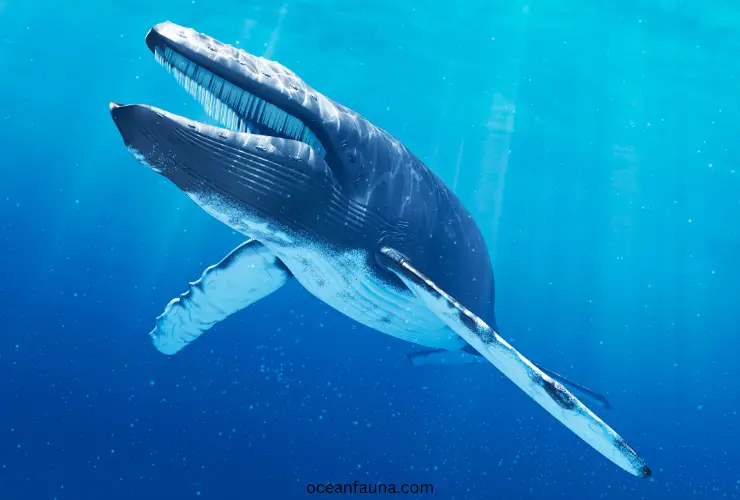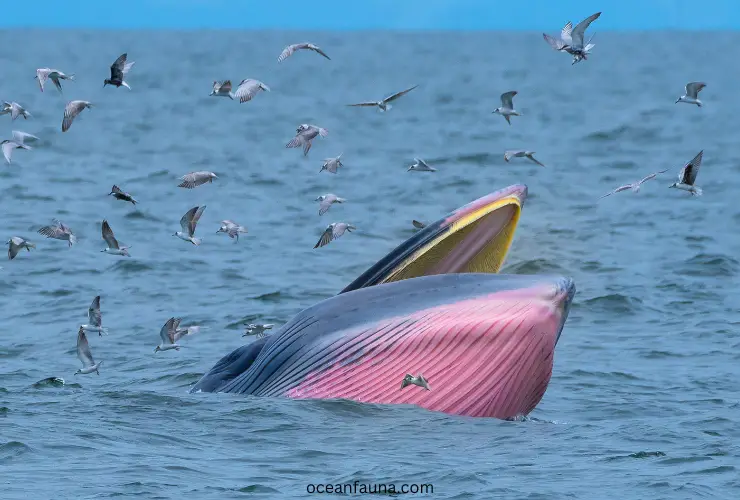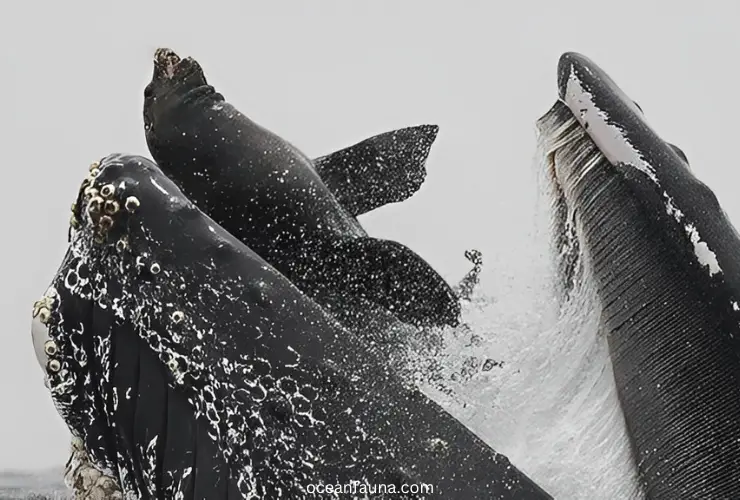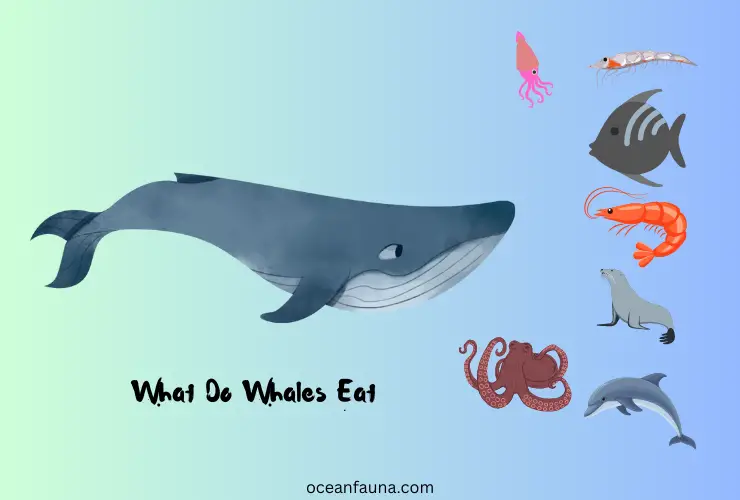Whales are among the largest and most intelligent creatures in the ocean. These mammals have a wide variety of food sources. They consume anything from small zooplankton to larger marine mammals and fish, depending on where they are in the food chain.
This article will provide a detailed discussion of whales’ diet, hunting skills, and daily nutritional requirements. So, read the entire article to learn more.
What Do Whales Eat?
Whales are known for their diverse diets, which include a plethora of species from various levels of the food chain. Some species of whales, such as humpbacks, prefer to feed on small schooling fish like capelin, herring, and sand lance. Even sometimes they may feed on sea birds. However, birds are not their daily meal.

Humpbacks use their baleen plates to strain vast amounts of water to capture these small prey items. Baleen plates are fringed and resemble a comb used to filter food from the water.
Other species, like the blue whale, the largest animal on earth, feed on krill, small crustaceans similar to shrimp. Blue whales can eat up to 4 tons of krill in a day. Like the blue whale, baleen whales have bristle-like structures protruding from the baleen plates that help them filter out their prey, making it easier for them to capture krill.
The sperm whale feeds primarily on squid. They can dive to great depths in the ocean to prey on these cephalopods, up to 10,000 feet deep. Sperm whales have a unique way of feeding, as they have teeth instead of baleen plates. They use their powerful jaws to capture their prey and are known to dive for up to 90 minutes in search of squid.
What Does a Blue Whale Eat?
The blue whale, the largest mammal on earth, feeds almost exclusively on krill, which are small, shrimp-like crustaceans that inhabit the cold, nutrient-rich waters of the Southern Ocean.
The feeding mechanism of the blue whale is truly remarkable. These gentle giants can consume enormous amounts of krill, up to 6 tons a day, by filtering seawater through their baleen plates. However, they can eat 10-20 tons of food per day.

Baleen is a fibrous material that hangs from the roof of the whale’s mouth and acts like a sieve. As the whale swims with its mouth open, seawater rushes in, along with krill and other small organisms.
The baleen plates trap the krill and other food particles, allowing the water to drain out. The whale then uses its tongue to push the trapped krill toward the back of the mouth, where it can be swallowed whole.
The blue whale’s diet is estimated to consist of about 70%-80% krill, but they may also occasionally eat small fish and squid. Blue whales must consume vast quantities of krill to sustain their immense size and energy needs. In fact, during the summer feeding season in the Southern Ocean, a single blue whale can consume over 1.5 million krill per day.
Blue whales are not aggressive hunters despite the enormous amount of food they consume. Instead, they are filter feeders, relying on their massive size and specialized feeding mechanism to catch the small, nutrient-rich krill that form the backbone of their diet.
Their unique feeding behavior is a testament to the remarkable adaptations that have allowed blue whales to thrive in some of the harshest environments on the planet.
Are Whales Carnivores Or Herbivores?
Whales are unequivocally carnivores. They survive exclusively on eating other animals, which means they are at the top of the food chain in the world’s oceans.
Even though some species of whales, such as baleen whales, swallow huge quantities of water and then filter out small animals like krill, shrimp, and small fish, they still consume living organisms, which makes them carnivorous.
Baleen whales have specialized teeth called baleen plates that help them filter out and eat the tiny aquatic animals they consume.
They essentially ‘sieve’ the water they take in and swallow everything caught by the baleen, which they then consume as food. Humpback whales are also considered large filter feeders, but they eat small fish and krill by filtering out the water in their mouths.
In addition to baleen whales, toothed whales feed on various sources of marine life, including fish, squid, octopus, and crustaceans. These whales have extremely sharp teeth that allow them to capture and eat their prey effectively.
Toothed whales, such as orcas and sperm whales, are known to hunt and capture other marine animals, including dolphins, seals, and even other types of whales.
Moreover, some whales consume large amounts of fat in their diet to sustain their enormous bodies. The blubber, a fatty layer beneath their skin, contains around two times more energy per unit of weight than protein or carbohydrates, allowing whales to store huge quantities of energy for migration and survival.

How Do Whales Eat?
Whales have evolved with unique feeding habits to ensure their survival. Their feeding technique depends on their size, species, location, and prey availability. Generally, whales are classified into two main groups based on feeding habits: baleen whales and toothed whales.
Baleen whales, such as the humpback, blue, or gray whale, filter feed using baleen plates, which are long, flexible, and fibrous structures in their mouth that act as a strainer. These plates trap small animals like krill, plankton, and small fish.
Baleen whales swim through massive schools of prey with their mouths open, fill up their mouths with a large amount of water, and then filter the water through their baleen plates, trapping the prey inside.
Toothed whales, such as the sperm, or pilot whale, have teeth and hunt for prey such as squid, fish, and marine mammals. To locate their prey in the water, toothed whales use echolocation. This involves them sending out high-frequency clicks and then listening to the echoes. Once their prey is located, toothed whales catch and kill it using their powerful jaws and teeth.
Some whales, such as the blue whale, have specialized throat muscles. These muscles expand greatly to allow them to swallow huge amounts of water-laden with prey.
Why Do Whales Eat Small Things?
Whales are known to consume relatively small prey despite their massive size, and the reason for this is primarily due to energy efficiency. These marine mammals spend a lot of energy in swimming and searching for food. So, it is more energetically advantageous for them to prey on smaller animals rather than attempt to hunt large game.
Furthermore, most species of whales have teeth that are not well-suited for breaking through flesh and bones, like those of some other predators, such as sharks or crocodiles.
Many whale species have baleen plates instead of teeth, which they use to filter small prey, such as krill and plankton, from the water. Baleen is made up of keratin, a protein found in our hair and nails, and is arranged in rows in the whale’s mouth, forming a mesh-like structure that traps food as they swim through the water.
In addition to baleen, some whale species, such as sperm whales, have teeth but still primarily prey on smaller creatures. Sperm whales are known to feed on a variety of prey, including squid, fish, and smaller marine mammals, such as seals and sea lions.

Even humpback whales, which are known for their impressive size, feed on small prey, such as krill and small fish.
Moreover, small prey is more abundant and easier to find than larger prey. For example, shoals of small fish are more likely to be found in shallower waters, making hunting for them more accessible and less energy-intensive than diving deep in search of larger prey.
When whales consume smaller prey, they are also more likely to be able to consume larger quantities of food, which is essential for their survival. This allows them to store more energy in their body, which can be critical when food is scarce.
Daily Nutritional Need of Whales
The daily nutritional need of whales can vary greatly depending on their size, habitat, and feeding habits. For example, a blue whale in the eastern North Pacific can consume between 10 and 20 tons of food daily, translating to around 20 to 50 million calories.
However, smaller species, such as the minke whale, may only consume about 1 to 1.5 tons of food per day, while larger species, like the sperm whale, may consume up to 2 tons of food daily.
Whales have incredibly high-energy requirements due to their enormous size and their need to maintain a constant body temperature in cold ocean waters. They also require a diet that is rich in protein, fat, and various micronutrients.
To meet their nutritional needs, whales often feed on tiny organisms such as krill or plankton or on larger prey such as fish and squid. For example, the humpback whale feeds primarily on krill and small schooling fish, while the killer whale (also known as the orca) is known to feed on a wide variety of prey, including fish, squid, seals, and even other whales.
The nutritional needs of whales can also vary depending on their life stage. For example, pregnant females and nursing mothers require more energy and nutrients to support their growing fetuses or calves. Certain species, such as the gray whale, also go through periods of fasting during their migratory journeys.
FAQs
Do all whales eat meat?
Yes, all whales are considered carnivores and eat meat as their primary source of nutrients. Some species, like the killer whale, have even been known to hunt larger marine animals, such as seals, sea lions, and other cetaceans. However, most whales primarily feed on small oceanic creatures like krill, shrimp, and squid.
Do whales eat sharks?
Only one type of toothed whale, the orca or killer whale, which belongs to the dolphin family, is known to eat sharks. Records show that killer whales have hunted hammerhead, mako, great white, thresher, and whale sharks. Also, when food sources are scarce, killer whales attack even the largest whale species.
Do whales eat dolphins?
While not all types of whales hunt dolphins, the killer whale (a member of the dolphin family) – which is a toothed whale – may hunt and eat other dolphins as part of their diet. However, this is not a regular case.
Do whales eat humans?
No, whales do not usually prey on humans. Whales primarily feed on small marine creatures like fish, krill, squid, and shrimp. When food is scarce, they also feed on larger animals, such as seals and sea lions. However, there have been isolated incidents in which killer whales have attacked humans in the wild or captivity, but such incidents are rare.
Conclusion
Now you have a compact idea of whales’ eating habits. I have discussed everything in detail, from what whales eat to the daily nutritional need of whales. From this article, you can understand that most species of whales feed on small oceanic creatures like krill and shrimp, while some species do hunt for larger prey such as fish and seals. Let me know if you have any further queries about the whales’ diet.


3 thoughts on “What Do Whales Eat? [Complete Food List]”